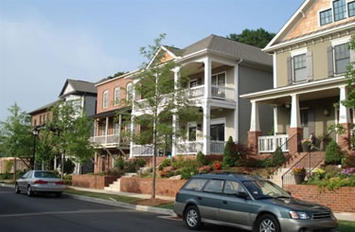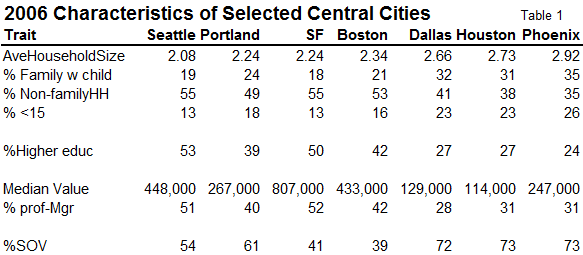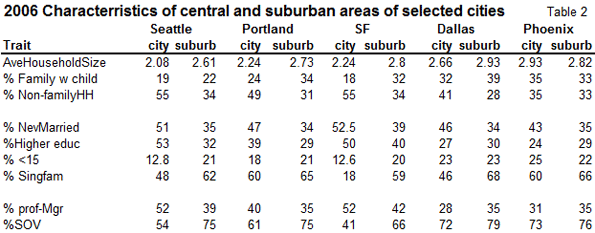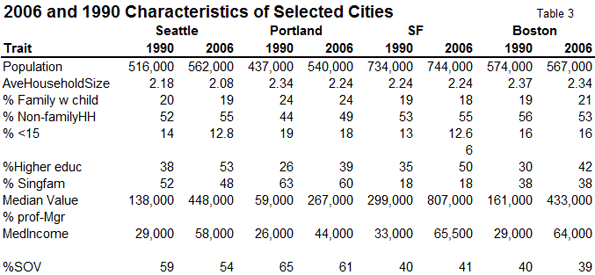
The United States has experienced a revolutionary change in social structure over the last 25 years, and this in turn has led to a significant change in settlement, especially the geography of many metropolitan areas.
At the risk of over-generalization, our society has shifted from a structure based on economic class to one based more on education and social values. The major parties confusedly reflect these changes. One astounding feature of our society is that wealth inequality has returned, not just to the levels of 1928, but even to 1913, and yet there is almost no sense of outrage as a basis for the mobilization of the relative have-nots (this helps explain the peculiarity of the 2008 elections).
Over this period, or somewhat longer, there has also been a deepening division of the population on what I’ll call the nature of educational outcomes. I used the word astounding above, and I’ll use it again to denote the scary inequality in factual knowledge and reasoning capacity of people, despite rising official levels of attainment. So there really is (as Rove et. al argued) an “intelligentsia” or intellectual elite. The hallmarks of this new “class” is higher education, environmentalism, liberalism or tolerance on social and cultural difference (religion, race, sexual preferences, etc) but also surprising affluence – almost what the word “liberal” meant in 19th and early 20th century Britain.
In my sphere of urban geography and planning, these characteristics have led to a surprising consensus on a “New Urbanist” vision (very popular word) – a return to a lost golden age, pre-suburb and pre-automobile, and in fact ghastly for most people. The movement began back in the 1960s (anti-sprawl, anti-suburb, anti-car, pro urban village) and came to dominate intellectual thought on city form and planning practice by the 1980s, and has certainly been given extra impetus by the “peak oil” crisis following 2001.
The urban geographic manifestation of this social and intellectual change has taken place through a revitalization and transformation of selected central cities, especially those with major universities.
This has taken three main forms: first, gentrification (displacement of poor and minority families by more educated and affluent professionals), but including idealist students and empty-nesters (returning from the suburbs); second, redevelopment or “densification” through large-scale rezoning from single-family home and low-rise arterial businesses, to multi-story apartments (from row houses to high towers); especially in designated major urban centers, which, third, will be linked to the downtown by rail transit.
While this movement has not, in fact, slowed the pace of suburban and exurban growth, even in cities where New Urbanist planning prevails, it has significantly altered several core urban cityscapes and concurrently, the social and economic structure of these cities. Typically lower and middle class families and minorities have been displaced out of the core, often to older suburbs, and been replaced by larger numbers of singles, or childless couples and empty nesters, many educated professionals. The shift of housing stock from single-family homes to apartments (rental or condo) is unattractive to many families, and often unaffordable, as higher density and parking constraints raise land and housing prices. The New Urbanist city is not childless of course, but relatively so, as many families are displaced or flee from the overpriced city.
We next look at how New Urbanist visions have played out in a small sample of cities, by first comparing a few core cities which have pursued such planning with a few that have not, then compare the more New Urbanist cities with their suburbs, and finally look at how the New Urbanist cities have changed since 1990. I’ll conclude with some thoughts on what this means to the nature of people and place. Is the New Urbanist city the ideal future in a post-oil world, or a failed social experiment?
Table 1 shows selected 2006 characteristics of four cities which are more affected by New Urbanist planning—Seattle, Portland, San Francisco and Boston and of three cities which have been less transformed: Dallas, Houston and Phoenix (but which have otherwise grown rapidly).

Portland and Seattle more recently pursued New Urbanist goals, and San Francisco and Boston more indirectly and long-term, while Dallas, Houston and Phoenix are more market-driven. It’s pretty amazing that Seattle matches or even exceeds San Francisco as the least familial, with traditional families constituting less than one-fifth of households, and children under 15 making up less than 13 percent of the population. In contrast Dallas, and Phoenix have almost twice as high a share of families with children under the age of 15.
Much higher shares of households are non-family (singles, or childless couples or unmarried partners) in the New Urbanist cities. Social, economic and housing characteristics differ markedly as well. Levels of educational attainment and of professional and managerial occupations are much higher, median house values are much higher and levels of commuting by single-occupant vehicles much lower.
Portland is less “advanced” on New Urbanist measures, even commuting by SOV?, although it has strong planning, rail transit, and started much earlier than Seattle. The main difference seems to be the much higher share of single-family homes (60 percent) in Portland than in Seattle (48), and a less constraining urban growth boundary.
Table 2 compares central city and suburban characteristics for five cities: Seattle, Portland, San Francisco, Dallas and Phoenix. The story is very simple. Suburban numbers for the New Urbanist cities are remarkably “normal” by U.S. metropolitan standards and are essentially like the central city and suburban values for Dallas or Phoenix. An intriguing feature of Dallas and Phoenix, compared to the New Urbanist metropolises, is that the suburbs still have higher status than the central cities (income, professional share, educational attainment). Seattle stands out, even more than San Francisco, as the only city with a higher city mean income than its suburbs. In other words, the distinctive feature of New Urbanist cities is the class shift, from gentrification and higher class redevelopment.

Table 3 compares the 1990 and 2006 values for four cities: Seattle, Portland, San Francisco and Boston. It is not really a surprise that what this tells us is that these “New Urbanist” cities were already in 1990 very unlike such cities as Phoenix, Dallas or Houston. Even before the arrival of stronger New Urbanist planning tools, Seattle, Portland, San Francisco and Boston were rather non-familial, fairly highly educated and moderately high in transit use.

It is true that each became a little less familial. Seattle and Portland were more affected by planning, with reduced single-family housing shares, and increased transit use. Portland grew more in population, reflecting a longer period than Seattle of planning denser urban settlement. Portland was also significantly less gentrified, in the sense of maintaining a higher share of less affluent households, although it had by far the highest housing price inflation --- three times the change in the CPI (Consumer Price Index). According to critics of Portland’s planning, this is a consequence of a longer period of stronger growth controls. But Seattle, San Francisco and Boston house prices were also twice the rate of change in the CPI. Median incomes increased well above the CPI rate (U.S. 55 percent) in Seattle (100), San Francisco (95) and Boston (119), but much less in Portland (71), indicating less gentrification in the latter.
What does all this mean? Does it matter if the New Urbanist cities are relatively childless/family unfriendly? Probably not, as there are nearby suburban jurisdictions more welcoming to families, more affordable and as rich in jobs. It is even likely that the New Urbanist planning was as much a reflection of the already “elitist” character of the cities, rather than being a cause of fundamental change. Even stranger, the New Urbanist planning seems to have responded to and pursued market preferences, although perhaps overzealously. That is, young professionals and empty nesters really wanted to live in the core and were willing to pay extra for the privilege.
The main social cost of the transformation --- in stark contrast to the stated goal of New Urbanist planning to recreate urban village communities of intense local interaction --- is that real world neighborhoods with single family homes, city or suburban, with children in local schools, have a stronger sense of community in large part because of the relative permanence of home ownership.
High density, New Urbanist core cities do encourage greater transit use, and use land more efficiently. Even if the majority of the population prefers suburban living or less dense central cities, will the end of the “age of oil” and concerns of global warming force the widespread adoption of new urbanism? I don’t think so, but that’s another story.













thanks
Took me time to read all the comments, but I really enjoyed the article. It proved to be Very helpful to me and I am sure to all the commenters here! It’s always nice when you can not only be informed, opal ring
great post
excellent. one of the best articles I have every read. This is the information which I have been searching. Great information. Ecopolitan EC | Ecopolitan EC price | Ecopolitan | Ecopolitan Punggol | Ecopolitan Executive Condo | Sea Horizon | Sea Horizon EC | Sea Horizon Executive Condo | Sea Horizon Executive Condominium | Sea Horizon Pasir Ris | Sea Horizon EC price | Tembusu Condo | Tembusu at Kovan | Tembusu Kovan | Tembusu condo Price | Tembusu | Vue 8 residence | Vue 8 residence price | Vue 8 Condo | Vue 8 Pasir Ris | Vue 8 | the inflora | inflora condo | inflora loyang | inflora this article is worth bookmarking. keep it up !